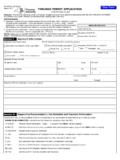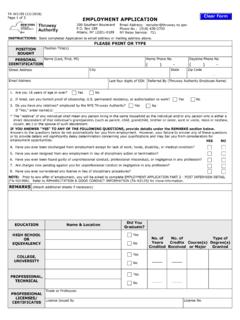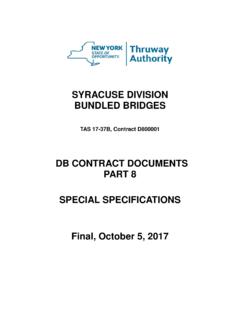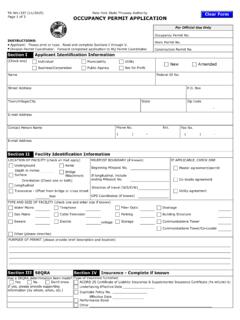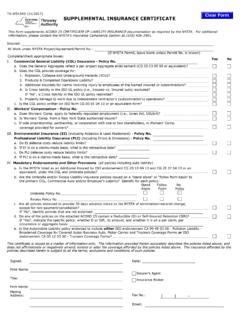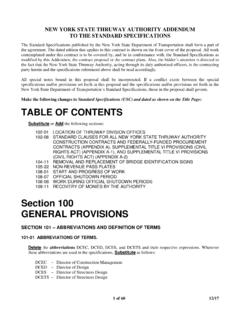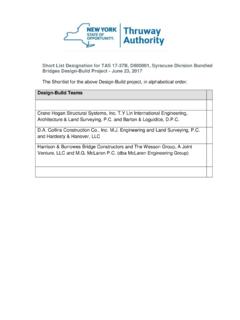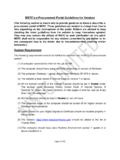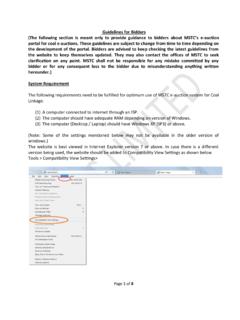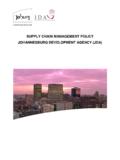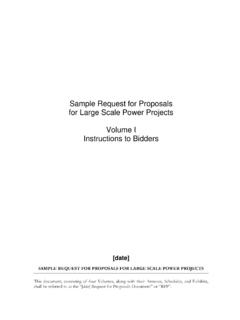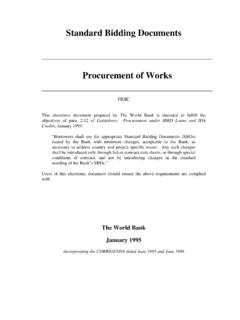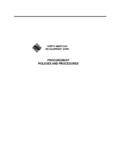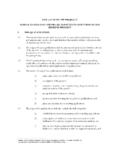Transcription of SECTION 5 - REINFORCEMENT
1 SECTION 5 REINFORCEMENT 5-1 SECTION 5 - REINFORCEMENT - GALVANIZED REINFORCEMENT Galvanized REINFORCEMENT shall be used in all locations. Galvanizing provides corrosion resistance by adding a sacrificial coating of zinc to the REINFORCEMENT . The zinc is consumed by the movement of electrons and, therefore, does not expand to the same magnitude that bare metal expands as it corrodes. Therefore, concrete cracking and spalling due to REINFORCEMENT corrosion is delayed until the zinc coating has been fully consumed. Stainless steel and stainless steel clad reinforcing steel is also available. These types of steel should only be used in highly corrosive marine environments with approval from the DSD. Refer to the NYSDOT Standard Specifications for the mechanical requirements of stainless steel reinforcing.
2 Also available is a high strength weathering reinforcing steel called MMFX. This steel has a design yield strength of 80 ksi. It is only used in locations where reinforcing congestion of 60 ksi needs to be reduced. This type of steel shall only be used with approval from the DSD. Refer to the Authority Special Specification for this product for additional information. The advantages of using galvanized REINFORCEMENT as compared to epoxy-coated REINFORCEMENT include: A. Better bond strength between the concrete and REINFORCEMENT . B. Shorter lap lengths. C. The galvanized coating is more durable during handling and installation requiring less touch- SECTION 5 REINFORCEMENT 5-2 up and repair of the galvanized coating.
3 D. The galvanized coating is chemically bonded to the bar, whereas an epoxy coating relies upon adhesion. E. The coating coverage requirements are more stringent, resulting in higher fabrication quality. F. Comparable unit cost. G. Longer service life. The following guidelines shall apply for galvanized REINFORCEMENT : A. The lap lengths and imbedment lengths for galvanized REINFORCEMENT are the same as for uncoated REINFORCEMENT . B. The out to out length of straight or shop bent galvanized bars should not exceed 40 feet. C. Galvanized REINFORCEMENT may be used in conjunction with existing uncoated or epoxy-coated REINFORCEMENT when necessary. - REINFORCEMENT GRADE All new and replacement bar REINFORCEMENT shall be ASTM A 615, GRADE 60.
4 (Billet steel only). Bars shall be galvanized and fabricated in accordance with ASTM A 767, and meet the requirements of NYSDOT Material Specification 709-11. - SPACING The spacing between parallel bars shall not be more than 18 inches or times the wall or slab thickness, whichever is less. For cast-in-place concrete, the clear distance between parallel bars in a SECTION 5 REINFORCEMENT 5-3 layer shall not be less than times the nominal bar diameter, times the maximum size of the coarse aggregate, or 1 inches, whichever is greater. For precast concrete (manufactured under plant control conditions), the clear distance between parallel bars in a layer shall not be less than 1 bar diameter, times the maximum size of the coarse aggregate, or 1 inch, whichever is greater.
5 When REINFORCEMENT is placed in beams and girders in two or more layers, the bars in the upper layers shall be placed directly above those in the bottom layer wherever possible. In concrete slabs, the reinforcing bars in separate mats shall be offset so that they are not directly over each other. The clear distance between bars shall also apply to the clear distance between a splice and an adjacent splice or bar. For structural elements designed by the LFD method, the flexural REINFORCEMENT shall be distributed in accordance with AASHTO 17th Edition Subsection For structural elements designed by the LRFD method, the flexural REINFORCEMENT shall be distributed in accordance with AASHTO LRFD 4th Edition Subsection - COVER The concrete cover required between reinforcing steel and the outside face of a structural unit is dependent on the type of structure and outside environment.
6 The following list indicates the minimum required cover for most circumstances. Traditionally Reinforced Deck Slabs on Beams or Stringers: Top of slab with separate wearing 2 in SECTION 5 REINFORCEMENT 5-4 Top of slab with integral wearing surface .. 2 in Bottom of 1 in Isotropically Reinforced Deck Slabs on Beams or Stringers: Top of slab with separate wearing 2 in Top of slab with integral wearing surface .. 2 in Bottom of 1 in 2 in Walls and piers above footings (including those adjacent to water) .. 3 in Footings (including unformed bottom) .. 3 in * Face of culverts in contact with earth ..2 in Bottom of bottom slab of culvert ..3 in Bottom of top slab of culverts and low rise rigid 1 in Arches, intrados and extrados.
7 2 in Precast and cast-in-place piles .. 2 in Precast piles exposed to sea water ..3 in All concrete surfaces exposed to sea water .. 4 in Top of sidewalk slabs .. 3 in Pedestal (Top) .. 3 in Pedestal (Sides).. 3 in * - When footings are placed on piles, the cover is normally measured from the top of the pile. However, if spacing allows, the designer may place the bottom mat of SECTION 5 REINFORCEMENT 5-5 REINFORCEMENT the cover distance above the bottom of footing. The concrete cover over seismic stirrups in substructure stems and footing where required shall be 2 inches except in salt water environments where the cover shall be 3 inches. - MAXIMUM BAR LENGTHS Specified bar lengths are limited due to fabrication and coating constraints and design considerations.
8 This allows for the most economical price by increasing the number of competing bidders. Most reinforcing bar plants in the United States produce bars in a standard length of 60 feet. However, most galvanizing tanks are limited to 40 feet long. Therefore, the maximum length of a straight galvanized bar should not exceed 40 feet. Where bars can be shop bent prior to galvanizing, the 40 foot length limitation applies to the out to out dimension of the bent bar. Where shop bending is not allowed (typically only on projects in NY Division), all bar bending is done in the field after galvanization. In this case, the length limitation would apply to the overall length of the bar. - SPLICING REINFORCEMENT - GENERAL During the design process, consideration must be given to splicing reinforcing bars.
9 This is necessary due to limited bar lengths (40 feet max.) and construction practices (stage construction). Splice lengths and locations shall be shown on the contract plans. The Thruway Authority generally accepts three types of splices: Lap Splices, Mechanical Splices and Welded Splices. See Detail SECTION 5 REINFORCEMENT 5-6 SECTION 5 REINFORCEMENT 5-7 Of the three, lap splices are the most economical, and so, should be used whenever possible. Lap splices shall be wired together the full length of the splice. Allowable mechanical splices are limited to the "screw" type. These are used at construction joints where space is limited. When splicing a galvanized bar to an existing epoxy-coated bar, the epoxy-coated bar splice length shall be used.
10 Mechanical splices are typically used at bulkheads of construction joints on staged construction projects. Space between the stages is usually limited. A bar that needs to be continuous between stages will end in Stage 1. A bar of the same diameter and appropriate lap length with a female flanged connection welded to the end is lapped to the Stage 1 bar and attached to the bulkhead at the flanged connection. During Stage 2, a second bar of appropriate lap length and a threaded end is screwed into the Stage 1 female connector. The appropriate Stage 2 bar is then lapped to this second bar. See Detail Welded splicing of REINFORCEMENT shall be limited to spiral REINFORCEMENT in pier columns & CIP piles, and replacement REINFORCEMENT in concrete repair areas where the appropriate lap length of the existing bar cannot be exposed.
